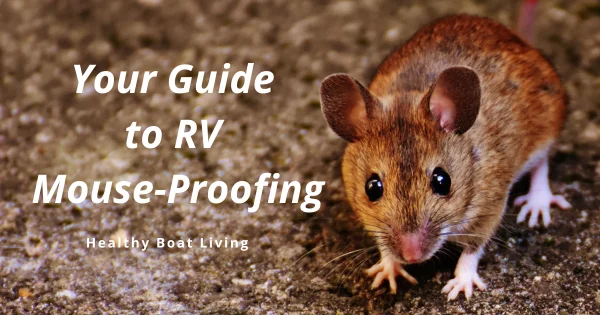Don't Let Mice Ruin Your Investment: Your Guide to RV Pest-Proofing
Published: 10/02/2025

Let's make your RV perimeter impenetrable to every rodent this season
Preparing your RV or boat for storage is about more than just draining the tanks—it's about protecting your investment from tiny invaders. Every year, thousands of RV owners face costly damage because they overlooked a critical step: rodent prevention. When the temperatures drop, mice and other pests are on the hunt for warmth and shelter, and your RV provides the perfect winter home, complete with nesting materials and hidden compartments.
Whether you're beginning your annual RV winterization process or just storing your vehicle for a few months, learning how to stop these destructive creatures is essential. This guide covers the complete strategy for effective mouse and pest exclusion, using proven deterrents, and ensuring safety so you can enjoy worry-free winter storage.
Don't risk expensive repairs—let's make your RV perimeter impenetrable to every rodent this season!
Fortifying the Perimeter – Rodent & Pest Prevention

Despite persistent rumors, this chew-marked bar of Irish Spring confirms: Mice are not deterred by strong soap.
Seal Entry Points: Inspect every inch of your RV (underside, slide-outs, compartments, around plumbing and electrical lines, vents) for tiny holes. Plug holes with steel wool or copper mesh followed by expanding foam or caulk. Cooper mesh is now recommended. Mice can push through steel wool. Seal the mesh with expanding foam.
Tip: At night, turn on all the lights in your RV, crawl under it to see where you see light. Those are the areas that mice enter through.
For RVs: Check around all slide-out mechanisms and wiper arm ports, as these are common spots where seals are imperfect. Secure the sewer hose bumper cap, as mice can climb right inside the bumper.
For Boats: Seal or cover the exhaust ports/outlets (using heavy-duty duct tape or marine foam plugs) and stuff the anchor locker vents. Protect engine air intakes by covering them securely.
Deterrents (Non-Toxic First): Mice hate strong scents, especially peppermint. Place strong peppermint oil-soaked cotton balls or Fresh Cab botanical pouches in strategic areas, especially under cabinets, in storage bays, and near suspected entry points.
Which Deterrent is Best?
• Irish Spring soap is a popular but unproven folk remedy for mice, relying on its strong scent. Results are inconsistent, with some RVers finding mice ignore or even chew on the bars. Do not rely on it as a primary solution; it is, at best, a supplementary deterrent used alongside sealing entry points, traps and EPA-registered repellent like Fresh Cab.
• Fresh Cab Botanical Pouches are an EPA-registered, commercially proven repellent using strong botanical scents like balsam fir oil. Unlike folk remedies, this product is independently tested to deter mice from nesting in stored RVs and vehicles. For best results, place multiple pouches near entry points and replace them regularly (typically every 30 to 90 days) to maintain the strong scent barrier. The manufacturer advises against using Fresh Cab with baits or traps. https://amzn.to/46XEwvo
• Peppermint oil. Because the oil evaporates quickly, you would need to check and replace or refresh the cotton balls every 3 to 7 days to maintain a meaningful deterrent effect.
• Traps (If Deterrents Fail): Use snap traps for humane killing. (Not glue traps).
Cleanliness is Key: Clean thoroughly. Absolutely no food left out or scented items left behind! Secure food in plastic totes or plastic food storage containers or these food containers.
Products for Deterring and Storage
Copper Wool (for plugging holes) or Copper Mesh
Expanding Foam Sealant: GREAT STUFF PRO Pestblock Insulating Foam Sealant or Stanley Expanding Foam Sealant
Fresh Cab Rodent Repellent Pouches
Mouse Traps: Victor M144 Metal Pedal Mouse Trap or Tomcat Wooden Snap Traps
Food storage Secure food in plastic totes or plastic food storage containers or these food containers.
EPA-Registered Versus EPA-Exempt
Not all botanical mouse repellents are EPA-registered because the Environmental Protection Agency (EPA) distinguishes between two types of products.
Fully EPA-Registered Pesticides, like Fresh Cab, have been tested, and the manufacturer has provided data to the EPA proving the product's safety and effectiveness (indicated by an EPA Registration Number).
In contrast to Fresh Cab, many other essential oil-based repellents are classified as EPA Exempt (Minimum Risk) Pesticides because their ingredients (like peppermint oil) pose minimal risk. These are exempt because their ingredients pose minimal risk. The EPA does not verify whether they actually work.
Fully EPA-Registered – Safe and Effective
There are only two EPA-registered botanical repellents in a pouch form: Fresh Cab and Stay Away Rodent.
Fresh Cab Botanical Rodent Repellent
Place the pouches in areas inaccessible to curious pets to prevent chewing or ingestion, which is the main risk with any essential oil product.
EPA Exempt – Effectiveness and Safety for Pets NOT Verified
Products that are "exempt" from full EPA registration have not been vetted for efficacy.
- Grandpa Gus's, Mouse Magic, Mighty Mint (Peppermint, Spearmint, Clove, etc.)
Other Essential Oil Repellents (Peppermint, Clove, etc.) CAUTION FOR CATS
While many essential oil repellents are sold as "pet-friendly" alternatives to poison, you must be very cautious, especially with cats. Cats lack a specific liver enzyme to properly metabolize compounds found in many common essential oils, including:
- Peppermint Oil
- Tea Tree Oil
- Eucalyptus Oil
- Citrus Oils (Lemon, Orange)
- Cinnamon Oil Ingestion, or even prolonged skin contact or inhalation from highly concentrated products, can be toxic to cats.
The bottom line is to always keep any repellent pouch or spray away from your pet's direct reach and to consult your veterinarian if your cat or dog ingests or has sustained contact with any essential oil product.
Reopening RV or Boat in the Spring
Inspection Checklist: Remove and dispose of all deterrents (pouches, cotton balls) before using the RV or boat.
Check the engine and cabin thoroughly for any chewed wires or nesting material that may have accumulated, as these can pose a fire hazard when the vehicle is started.
Electronic and Ultrasonic Devices
These devices are increasingly popular for RV and marine storage, but their effectiveness is debated by pest control experts.
How They Work: They plug into an outlet (or a 12V battery source for storage) and emit high-frequency sound waves (25 kHz to 45 kHz) and often feature flashing LED strobe lights. The goal is to create an annoying, hostile environment that deters rodents from nesting.
The Caveat: Rodents can become acclimated to a single, constant frequency. For them to be effective, you must use high-quality units that vary the frequency and sound pattern. Also, ultrasonic sound waves do not penetrate walls, cabinets, or dense objects, so you may need multiple units for a large RV or boat cabin.
Best Use: They can be highly effective when combined with exclusion, particularly in engine compartments (where they can be hardwired) or when plugged into the main cabin, as they provide a continuous deterrent while the unit is stored.
While many generic plug-in ultrasonic devices are sold on Amazon, the brand that consistently stands out in the RV/automotive protection space for its dedicated devices is MouseBlocker.
MouseBlocker PROx 12V (Wired): For under the hood/engine bay, wired directly to the battery.
MouseBlocker PROx Plug-in (120V): For inside a car, RV, or boat cabin, or placed right next to it, using a wall outlet.
MouseBlocker 1000x (120V): For large building spaces like an entire 2-car garage or a large warehouse bay.
Follow Us for More

Follow along with us, Captain Maria, and my husband George aboard our 30' Tollycraft, "Little Bear"! We're exploring the stunning San Juan Islands and bringing you along for the adventure.
As a registered dietitian and master personal trainer, I have a private practice in Sammamish, Washington, where I help people create a healthy lifestyle. Now, I'm bringing that same dedication to the water. I combine my deep knowledge of nutrition and fitness with my skills as a captain, creating a unique approach to help you feel strong, vibrant, and fully alive, wherever you are on your travels!
Blog: https://www.myactivenutrition.com/category/healthy-boat-living
YouTube: https://www.youtube.com/@HealthyBoatLiving
Facebook: https://www.facebook.com/HealthyBoatLiving
Instagram: https://www.instagram.com/healthyboatliving
Categories: Healthy Boat Living RV and Camping





